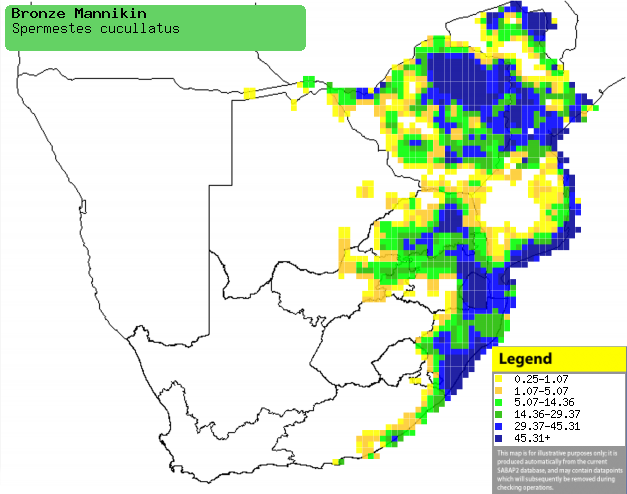|
Spermestes cucullatus (Bronze
mannikin)
Gewone fret [Afrikaans]; Ingxenge, Ungxenge
[Xhosa]; Zadzasaga [Shona]; Rijajani (generic term for mannikin) [Tsonga]; Gewoon
ekstertje [Dutch]; Capucin nonnette [French]; Kleinelsterchen [German];
Freirinha-bronzeada [Portuguese]
Life
> Eukaryotes >
Opisthokonta
> Metazoa (animals) >
Bilateria >
Deuterostomia > Chordata >
Craniata > Vertebrata (vertebrates) > Gnathostomata (jawed
vertebrates) > Teleostomi (teleost fish) > Osteichthyes (bony fish) > Class:
Sarcopterygii (lobe-finned
fish) > Stegocephalia (terrestrial
vertebrates) > Tetrapoda
(four-legged vertebrates) > Reptiliomorpha > Amniota >
Reptilia (reptiles) >
Romeriida > Diapsida > Archosauromorpha > Archosauria >
Dinosauria
(dinosaurs) > Saurischia > Theropoda (bipedal predatory dinosaurs) >
Coelurosauria > Maniraptora >Aves
(birds) > Order: Passeriformes
> Family: Estrildidae
Distribution and habitat
Occurs across much of sub-Saharan Africa, from Senegal to
Ethiopia south to southern Africa. Here it is very common in Mozambique,
Zimbabwe, Swaziland and eastern South Africa, while more scarce in northern and
south-eastern Botswana and the Caprivi Strip (Namibia). It generally prefers
grassy habitats with a few scattered bushes and trees, such as edges of thickets
or evergreen forest, savanna, suburban gardens and the border between natural
vegetation and cultivated land.
|
 |
|
Distribution of Bronze mannikin in southern Africa,
based on statistical smoothing of the records from first SA Bird Atlas
Project (©
Animal Demography unit, University of
Cape Town; smoothing by Birgit Erni and Francesca Little). Colours range
from dark blue (most common) through to yellow (least common). |
Predators and parasites
It (at different stages of development) has been recorded
as prey of the following animals:
Food
It mainly eats grass seeds supplemented with with insects,
doing most of its foraging on the ground, often taking advantage of feeding
trays. The following food items have been recorded
in its diet:
- Seeds
- grass
- Eleusine coracana (African millet grass)
- Sporobolus pyramidalus (Catstail grass)
- Panicum maximum (Guinea grass)
- Setaria
- S. homonyma (Fan-leaved bristle grass)
- S. sphacelata (Twisted-leaf bristle grass)
- S. pallide-fusca (Garden bristle grass)
- Echinochloa pyramidalis (Limpopo grass)
- Brachiaria nigropedata (Spotted signal grass)
- Paspalum urvillei (Vasey grass)
- Melinis repens (Natal red top)
- Melinis nerviglumus (Bristle-leaved red top)
- Hyperthelia dissoluta (Yellow thatching grass)
- Cynodon dactylon (Couch grass)
- Poa annua (Annual bluegrass)
- Bidens pilosa (Common blackjack)
- Arthropods
Breeding
- The male gathers material used by the female to build the nest, which
consists of an untidy ball-shaped structure, usually made of green grass
inflorescences but sometimes incorporating pine (Pinus) needles and
wild Asparagus stems. It is typically placed in a bush, tree or
man-made structure, such as a post or beam of a building.
- Egg-laying season is from August-May, peaking from November-April.
- It lays 2-8 eggs, which are incubated by both sexes for about 12-16
days.
- The chicks are fed by both parents on a diet of mainly seeds, leaving
the nest after about 15-21 days and becoming fully independent roughly 4
weeks later.
Threats
Not threatened, in fact it has adapted well to the
modification of habitats by man.
References
-
Hockey PAR, Dean WRJ and Ryan PG 2005. Roberts
- Birds of southern Africa, VIIth ed. The Trustees of the John Voelcker
Bird Book Fund, Cape Town.
|
